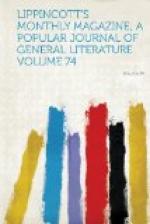The Koutab Minar, which I had first viewed nine miles off from one of the little kiosquelets crowning the minarets of the Jammah Masjid, improved upon closer acquaintance. One recognizes in the word “minaret” the diminutive of “minar,” the latter being to the former as a tower to a turret. This minar of Koutab’s—it was erected by the Mussulman general Koutab-Oudeen-Eibeg in the year 1200 to commemorate his success over the Rajput emperor Pirthi-Raj—is two hundred and twenty feet high, and the cunning architect who designed it managed to greatly intensify its suggestion of loftiness by its peculiar shape. Instead of erecting a shaft with unbroken lines, he placed five truncated cones one upon another in such a way that the impression of their successively lessening diameters should be lengthened by the four balconies which result from the projection of each lower cone beyond the narrower base of the cone placed on it—thus borrowing, as it were, the perspective effects of five shafts and concentrating them upon one. The lower portion, too, shows the near color of red—it is built of the universal red sandstone with which the traveler becomes so familiar—while the upper part reveals the farther color of white from its marble casing. Each cone, finally, is carved into reeds, like a bundle of buttresses supporting a weight enormous not by reason of massiveness, but of pure height.
The group of ruins about the Koutab Minar was also very fascinating to me. The Gate of Aladdin, a veritable fairy portal, with its bewildering wealth of arabesques and flowing traceries in white marble inlaid upon red stone; the Tomb of Altamsh; the Mosque of Koutab,—all these, lying in a singular oasis of trees and greenery that forms a unique spot in the arid and stony ruin-plain of Delhi, drew me with great power. I declared to Bhima Gandharva that it was not often in a lifetime that we could get so many centuries together to talk with at once, and wrought upon him to spend several days with me, unattended by servants, in this tranquil society of the dead ages, which still live by sheer force of the beautiful that was in them.
“Very pretty,” said my companion, “but not by force of the beautiful alone. Do you see that iron pillar?” We were walking in the court of the Mosque of Koutab, and Bhima pointed, as he spoke, to a plain iron shaft about a foot in diameter rising in the centre of the enclosed space to a height of something over twenty feet. “Its base is sunken deeper in the ground than the upper part is high. It is in truth a gigantic nail, which, according to popular tradition, was constructed by an ancient king who desired to play Jael to a certain Sisera that was in his way. It is related that King Anang Pal was not satisfied with having conquered the whole of Northern India, and that a certain Brahman, artfully seizing upon the moment when his mind was foolish with the fumes of conquest, informed him there was but one obstacle to his acquisition of eternal




